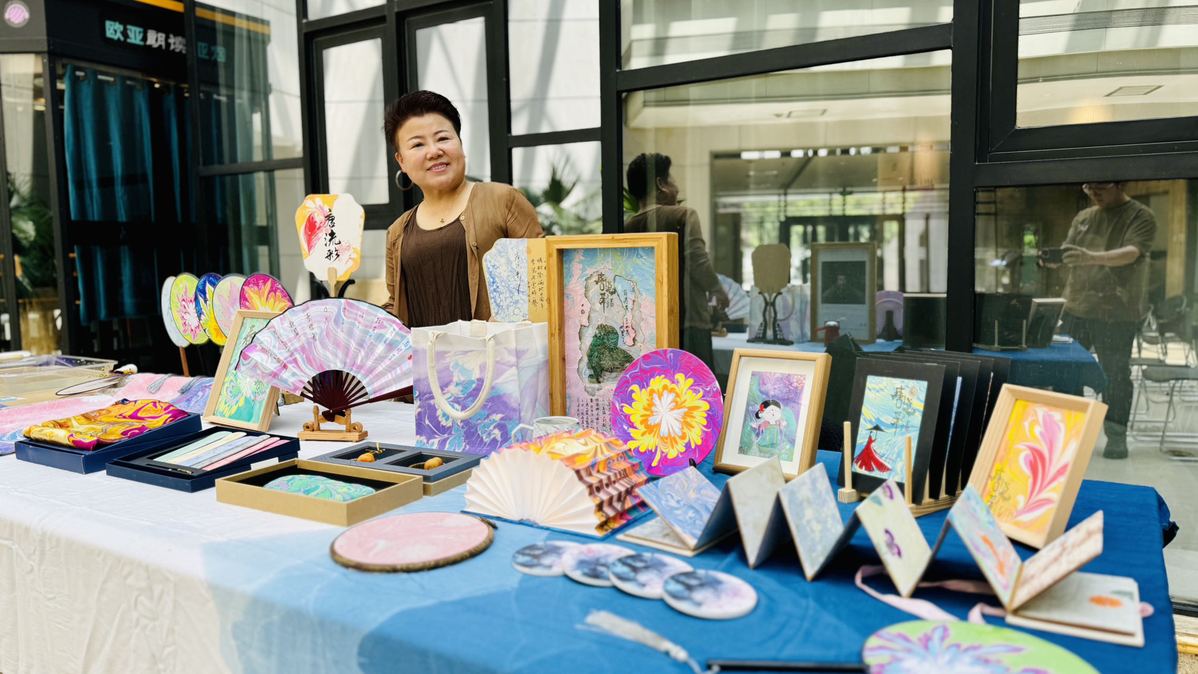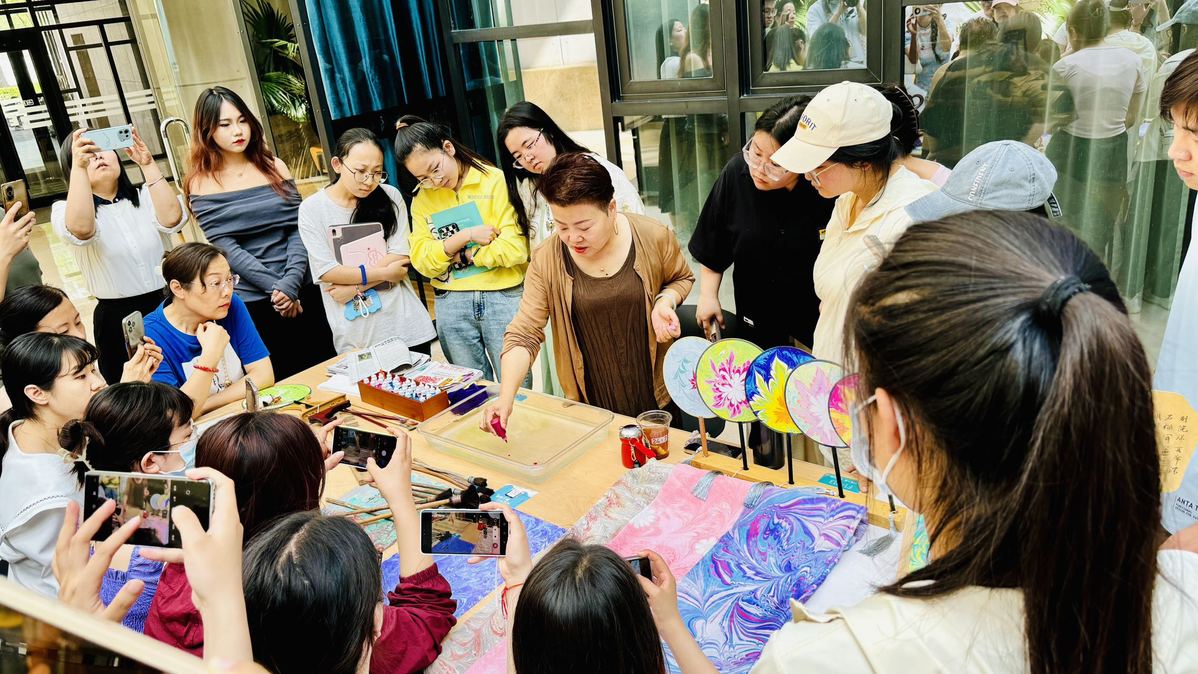
Restoring a Colorful Tradition to Dye for

A dazzling pattern comes into shape by the skilled hands of Zhang Shuangmin, an inheritor of the traditional art form tangliucai.[Photo provided to China Daily]
Zhang Shuangmin might look a bit haphazard as she drips pigment onto a square container of water. The pigments immediately disperse into small circles once they touch the surface of the transparent liquid, and without wasting any time, Zhang swirls them with an awl in seemingly casual movements.
As minutes pass, the random arrangement of pigments begins to take shape and eventually evolves into stunning floral patterns.
A bigger surprise comes when she gently places a white porcelain plate into the water and lifts it in slow motion. The pattern then magically transfers onto the plate.
This procedure never fails to elicit a gasp of amazement from her audience.
This type of printing art is known as tangliucai (Tang flowing colors), and Zhang, 53, has practiced the craft for more than three decades.
"It requires calculation and precision every step of the way," says Zhang, who was born and raised in Xi'an, Shaanxi province.
"I need to have a design in mind before execution. If I want a pattern to appear in warm colors, I need to plan ahead and use cool colors for the background.
"I also have to consider beforehand if I will place it on a folding or round fan, a porcelain plate, silk, leather, or any other medium, which will determine the composition of the pattern and ultimately the success of the work."
Years of practice has seen Zhang develop a strong leaning toward bringing out Tang Dynasty (618-907) elements when practicing the craft of tangliucai, which was named an intangible cultural heritage in Xi'an in 2020.
"I want it to match the historical thickness of the art, which boasts a long history," Zhang says.
Zhang was first attracted to a rough version of the craft from her grandmother, who would steep various fabrics into dyes, resulting in intriguing patterns.
This childhood predisposition to the dyeing art prompted her to pursue design and environmental art at a local art institute in the 1990s, when she got to know her grandmother's daily life production might be associated with the ancient water-printing technique.
In Youyang Zazu (The Miscellaneous Morsels From Youyang), a compilation of diverse social and folk narratives by Tang Dynasty writer Duan Chengshi, an ancient technique of coloring paper on water was detailed.
Experts regard this collection as the earliest documentation of the historical roots of the practice.
Then, in the compilation titled Four Treasures of a Scholar's Study by Song Dynasty (960-1279) scholar Su Yijian, a kind of decorative paper called liushajian, meaning flowing-sand notepaper, was mentioned of being made in what is now Sichuan province.

Zhang Shuangmin, 53, introduces a wide range of products featuring the art of tangliucai at a university in Xi'an, Shaanxi province. [Photo provided to China Daily]
According to this collection, the process of notepaper production involved pulling a sheet of paper through a fermented flour paste combined with an array of colors, resulting in spontaneous and asymmetrical patterns.
Furthermore, the compilation described an alternative method using a paste derived from a regional plant blended with croton oil and diluted with water.
Ginger extract was subsequently employed to scatter the hues. Then a hairbrush was used to create designs resembling human figures, clouds or flying birds.
These intricate designs were then transferred onto a paper surface, showcasing the artistry and skill of the creators.
"It was so fascinating, yet a great pity," Zhang says about the fact that the art form failed to prosper and was almost on the brink of extinction in the country.
As she delved further into her research, she discovered that this art form had transcended borders and acquired unique local characteristics, such as in Turkiye, where the marbling art known as Ebru was inscribed on the Representative List of the Intangible Cultural Heritage of Humanity of UNESCO in 2014.
She made a point to pursue the art through scraps of information from historical documents.
"Many people said it had died. It is not true since we can still find the water-printing technique continuously being applied in marbling Xuan paper," Zhang says.
Handmade Xuan paper, or rice paper, was originally produced during the Tang Dynasty in Jingxian county in today's Anhui province, and calligraphy and painting artists have put a premium on it ever since.
With an art background, Zhang managed to piece together bits of information and restore the craft through consultations from experts and her own expertise.

The artisan demonstrates the creating process to university students.[Photo provided to China Daily]
Demanding process
Bright colors and highly fluid patterns are pleasing to the eye, but the techniques behind them challenge one's patience and commitment to delivering the art.
"The creation of tangliucai seems simple, but it puts an artist's skill through its paces," she says.
"For instance, the color combination, the amount of pigment and the placement of the drops all require repeated consideration and judgment," she adds.
Other tough aspects include the selected angle and strength for painting, as well as the concoction of the painting liquid, all of which must be done to a turn.
"The strength in execution determines the smooth flow of the painting," Zhang says.
Regarding the painting liquid mixture, she formulated her own sizing (a gelatinous solution) by adapting her grandmother's recipe through a process of trial and error.
"If the liquid is too thick, the pigment won't spread; if it's too thin, the pigment will either sink or spread excessively," she explains.
Additionally, the painting process must be completed within 20 minutes to prevent deformation and the formation of grainy edges in the pigment. The most crucial stage arrives when transferring the pattern onto the medium after completing the painting.
"Maintaining a bubble-free transfer is paramount. The intrusion of air can lead to the formation of white spots, potentially ruining the entire piece in an instant," she says.
In the event of a misstep, the only recourse is to innovate based on the resulting error and transform it into art.
"In essence, it demands a tranquil mind, concentration on the water's surface and unwavering hands," Zhang concludes.
Even with decades of experience under her belt, she is cautious every time she starts a new creation.
"This is an art that can transform decay into magic, with success or failure occurring in an instant," she says.
For her painting content, it revolves around Chinese cultural elements, including clustered floral patterns, classic paper-cutting images and cultural relics.
From 2014, Zhang began to apply the art to decorative items for her friends' homestay businesses, which are popular among the owners and their guests.

Zhang's creations draw a big crowd during a tourism event in Xi'an.[Photo provided to China Daily]
Youthful inheritors
As her skills continue to improve, Zhang says she feels an increasing urge to promote the art to a broader audience.
Since she was granted the status of an inheritor, she has formed partnerships with local schools to teach the art on campus and developed learning tours for visitors to appreciate its charm.
"Many students have shown great interest in learning about the art and they have been committed to the process," Zhang notes.
She just completed a yearlong training with 20 primary school pupils in Xi'an in late June.
Alongside teaching technical skills, Zhang inspired them to unleash their creativity by experimenting with color combinations and designing patterns.
Zhang has also received invitations to showcase her creations at social communities, major automobile companies and insurance firms that have sought her expertise for team-building activities and customer experiences.
To date, Zhang has more than 20 disciples who have followed her in pursuit of the art for many years.
Li Xinyu, 23, began learning from Zhang in 2019.
"I was stunned by its creation process and beauty at the first sight," says Li, a Xi'an native.
She has grasped the basic skills and can independently pull off simple works.
"It is an art that requires long-term accumulation and continuous innovation. I am still learning and improving," Li says.
She says she has been inspired by Zhang's focus on details, patience in fine-tuning students' skills and support for innovation.
"Now, tangliucai is more like a form of art therapy for me since it brings peace to my mind and teaches me how to deal with details and draw experiences from failure," Li says.
The rising popularity of tangliucai has convinced Zhang that giving the audience a sense of participation and achievement is key to carrying the art forward.
"Young people value special customization and the feeling of uniqueness. They might give a scarf to their girlfriend, a hat or a pair of sneakers to a good friend. So, I leverage this mindset to apply tangliucai to more media that are close to their hearts," Zhang says.
To date, derivatives carrying the water-printing elements have covered ceramics, scarves, tote bags, shoes and hats.
"I love the splendid colors of tangliucai, but what I love the most is the smile on the faces of my students when they complete a painting," Zhang says.